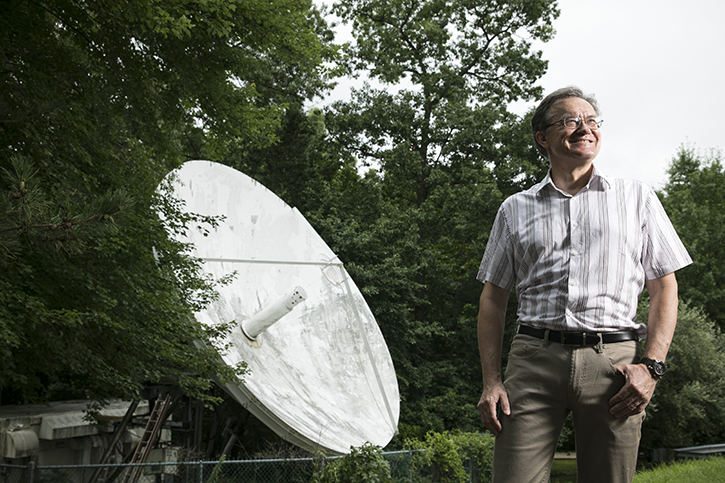
Associate professor Peter Pachowicz said the salvaged satellite dish gives Mason students the chance to "join the renewed space race." Photo by Ron AIra.
Sometimes the race to space begins in your own backyard.
That was the case for George Mason University's Peter Pachowicz, associate professor of electrical and computer engineering.
Last winter, Pachowicz got word that a 27-year-old, 30-foot satellite dish on the Fairfax Campus was going to be demolished.
“If we didn’t take it, it was headed to the scrap yard,” he said.
Pachowicz looked to CACI, a longtime corporate partner of the Volgenau School of Engineering, for help. CACI is a provider of information solutions and services—including satellite engineering and space operations—in support of national security missions.
The company agreed to sponsor a project to make the satellite dish—which is being donated and financially supported by a subsidiary of the George Mason University Instructional Foundation—available to students.
“This satellite dish is a powerful system that ignites the excitement of everyone involved in the project,” said John Mengucci, the company’s chief operating officer. “It represents a unique opportunity for CACI engineers to join forces with Mason students and faculty as they explore the outer limits of what is possible.”
The dish, which Pachowicz dubbed Space Communications Ground Station, or SpaceCom, will be used to receive signals, data and images from satellites as well as signals from missions to the moon. “Mason students can join the renewed space race,” he said.
It will also serve as a platform for hands-on student projects, including senior design projects and student club activities.
“The dish will be the largest satellite dish in the Washington, D.C., area available to undergraduate students,” Pachowicz said, adding that a new dish this size would cost between $1.2 million and $1.3 million.
The dish will be available to students in the engineering school, as well as those in other Mason schools and colleges. Students will gain multidisciplinary, hands-on experience in all aspects of the renovation, including electronics, radio frequency hardware, computers, software and signal processing.
Pachowicz said there are plans to create a weak signal amateur club, allowing students to conduct moon bouncing, or Earth-moon-Earth communications, which involves exchanging messages through a reflection off the moon’s surface.
“It’s extremely challenging because the signal coming back from the moon is extremely weak,” he added.
Other benefits would include hands-on experience communicating with spacecraft traveling to the moon and with satellites, he said.
“We believe that the involvement of students in all aspects of dish modification and upgrades will provide an unprecedented learning opportunity,” Pachowicz said.
When Pachowicz tells students about this opportunity, “[they] jump at the chance and ask when they can work on it.”
